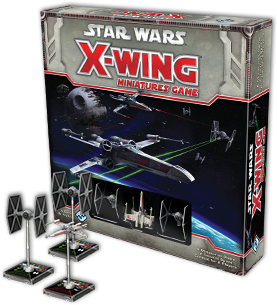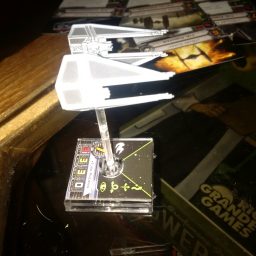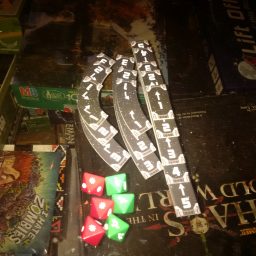WARGAME WEDNESDAY: Pursuit of Perfection: Star Wars X-Wing Miniatures Game
Wednesday , 31, August 2016 Wargames 2 Comments A new series! I’m taking a break from overarching principles of wargaming to look at specific Wargames and what they do well. This examination stems from a belief that a perfect Wargame has not been made and the best is yet to come. I’m something of a game designer, which means I spend way too much time thinking about decisions other game designers made and setting myself up as an unqualified judge instead of producing games of my own. Wait a minute, that’s not what I meant to—
A new series! I’m taking a break from overarching principles of wargaming to look at specific Wargames and what they do well. This examination stems from a belief that a perfect Wargame has not been made and the best is yet to come. I’m something of a game designer, which means I spend way too much time thinking about decisions other game designers made and setting myself up as an unqualified judge instead of producing games of my own. Wait a minute, that’s not what I meant to—
Moving on, today we have a Star Wars game in the crosshairs. It’s called X-Wing but honestly the name is the biggest nutzoid cash-in I’ve seen from a brand in a while; there lacks the focus on the iconic craft that previous branded games [X-wing Vs Tie Fighter, etc] have had, and when considered it is quite jarring. Past the name though, there’s a solid game under the hood, with the franchise owned by Fantasy Flight Games and a community up and running since late 2012. Each player assembles a squad list of snubfighter and small craft from the familiar and much-beloved universe, from the nimble yet fragile TIE fighter to the massive Ghost, and then they maneuver their forces in a deathmatch or scenario. As you can see, the manuals are quite thin but the game’s tremendously clear rule-set is the champion of the day. This game aims to get players into the action as fast as possible, with priority order and resolution of actions snapping to right along with the players. It’s very clean.
It is a game in two dimensions, but it retains some of the ideas of maneuvers and loops, flips, and barrel rolls. Players have to contend with asteroids and there are mines, torpedoes, aces and special abilities and equipment galore, allowing tons of customizability and a variety of lists: Imperial Aces, Alpha Lockdown, Shuttles Go, Fat Han, Ninja Droids, Rebel Spam, Emperor’s Guidance, Imperial Crackswarm, U-boats… And many more, each clad in the half-respectful, half-denigrating parlance of competitive-types.
 This game does several things very well, and a few things pretty well. Firstly, all of the major relevant statistics for a unit are visible at a glance as you can see in the picture. Color-coded, distinct iconography, and pretty neat ship models to boot. My picture really doesn’t do it justice. In the same picture, you can see the detailed cards each player uses to track things on their bookkeeping side, chiefly damage but also which upgrades which ship has and the like. Having all the major details in view without sacrificing the game’s iconic models blew me away; a coup de force in design and playability. New players don’t have to necessarily memorize large charts just to begin playing at reasonable speeds, veteran players don’t have to read and process a whole statline just to process a new ship they’ve not seen before, and newly-released ships will hit the tables with ease. It also adds to some of the spectatorial appeal, even for those who know little about the game.
This game does several things very well, and a few things pretty well. Firstly, all of the major relevant statistics for a unit are visible at a glance as you can see in the picture. Color-coded, distinct iconography, and pretty neat ship models to boot. My picture really doesn’t do it justice. In the same picture, you can see the detailed cards each player uses to track things on their bookkeeping side, chiefly damage but also which upgrades which ship has and the like. Having all the major details in view without sacrificing the game’s iconic models blew me away; a coup de force in design and playability. New players don’t have to necessarily memorize large charts just to begin playing at reasonable speeds, veteran players don’t have to read and process a whole statline just to process a new ship they’ve not seen before, and newly-released ships will hit the tables with ease. It also adds to some of the spectatorial appeal, even for those who know little about the game.
The chief consideration for bringing this game to your attention as a wargame is its interesting design choices for tracking happenings in game. Usability is important. When I first sat down to play, I was thrilled at how clean and clear everything was, with the slight advantage on their custom dice to the attacker and a simplification of all the games I’d grown frustrated with using flexible rulers and dealing with ten thousand oh-so-similarly nuanced terrain types arrived—neat little dials are preset for each ship, and a limitation is set on what maneuvers can be done, visible by the small pile of measuring sticks next to the dice. Brilliance. Speed.
 However, the brilliance faded. Rather than continue to go with a clear and simple approach, they used tokens like many other Wargames to denote status: Focus, Evade, Target Locks, etc. These are an absolute distraction, as are the damage cards; where are you supposed to put them? The game’s figures and terrain are so lightweight that accidental bumps and incidental hands flying over the table to deal with tokens inevitably disrupt things. This system works in other Wargames with their different sizes of units and sturdier terrain and less vertical models, but here it has consistently interrupted and bogged down gameplay. I’ve adapted to dealing with all of the token on the pilot cards back in my zone, but that’s clearly something that would irk tournament-players.
However, the brilliance faded. Rather than continue to go with a clear and simple approach, they used tokens like many other Wargames to denote status: Focus, Evade, Target Locks, etc. These are an absolute distraction, as are the damage cards; where are you supposed to put them? The game’s figures and terrain are so lightweight that accidental bumps and incidental hands flying over the table to deal with tokens inevitably disrupt things. This system works in other Wargames with their different sizes of units and sturdier terrain and less vertical models, but here it has consistently interrupted and bogged down gameplay. I’ve adapted to dealing with all of the token on the pilot cards back in my zone, but that’s clearly something that would irk tournament-players.
While a fine game, it’s important to think about the small stuff and how it will be used on the table. In an age when computers rule most games and all the math and states and tracking can be whisked away by digitization, there is much less tolerance for games which do not do all that they can to minimize or streamline these tolerances at the table. The clarity is top-notch in X-Wing Miniatures; the usability lags behind.
The present builds the future and is built upon the past. The best games are yet to be made, but let’s appreciate the ones we have now.
– Zac
Please give us your valuable comment